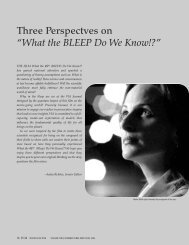The Heart of Brother Wayne Teasdale's Vision of ... - Vision in Action
The Heart of Brother Wayne Teasdale's Vision of ... - Vision in Action
The Heart of Brother Wayne Teasdale's Vision of ... - Vision in Action
Create successful ePaper yourself
Turn your PDF publications into a flip-book with our unique Google optimized e-Paper software.
Buddhist “shunya” or empt<strong>in</strong>ess, however, is not total noth<strong>in</strong>gness nor completeabsence; beneath this empt<strong>in</strong>ess <strong>of</strong> <strong>in</strong>dividual and impermanent forms lies a deeper <strong>in</strong>terconnectedness<strong>of</strong> Be<strong>in</strong>g, <strong>of</strong> “co-dependent aris<strong>in</strong>g” as the Buddhists call it.<strong>The</strong> transient world <strong>of</strong> pass<strong>in</strong>g forms and this deeper <strong>in</strong>ter-connectedness <strong>of</strong> Be<strong>in</strong>gtogether form what the Buddhists call “immanent empt<strong>in</strong>ess.” What is it whichexperiences and recognizes this “immanent empt<strong>in</strong>ess?”It is aga<strong>in</strong> Consciousness, the Light <strong>of</strong> Awareness, which the Buddhists call“transcendent empt<strong>in</strong>ess,” “cogniz<strong>in</strong>g empt<strong>in</strong>ess,” the “empt<strong>in</strong>ess” which is “fullness,”which does not pass away.As <strong>Wayne</strong> expresses it, “Ultimate, or transcendent empt<strong>in</strong>ess is equivalent topar<strong>in</strong>irvana, or the goal <strong>of</strong> existence as boundless consciousness beyond desire andpersonal identity” (MH, p.57).In this way, <strong>Wayne</strong> identifies the mutual ground <strong>of</strong> both Buddhism and H<strong>in</strong>duismas pure and universal Consciousness.How does he do the same for Christianity?He beg<strong>in</strong>s with Plato and Aristotle whom he says share the same core dualism <strong>of</strong>m<strong>in</strong>d/soul as separate from body. For Plato, this dualism is antagonistic; the soul is a“prisoner” <strong>of</strong> the body. For Aristotle, the relationship is more co-operative. <strong>The</strong> soul isboth the “animat<strong>in</strong>g” and the “<strong>in</strong>telligent” substance or force. First it provides movementand mobility to “primary” matter; it “enlivens” it. It also provides a cogniz<strong>in</strong>g or<strong>in</strong>telligent aspect, once aga<strong>in</strong>, awareness or Consciousness.For Aristotle, this is the higher function <strong>of</strong> the soul, “active reason.” It is “active”reason or “m<strong>in</strong>d” which separates from the body and has an <strong>in</strong>dependent and perpetual8



